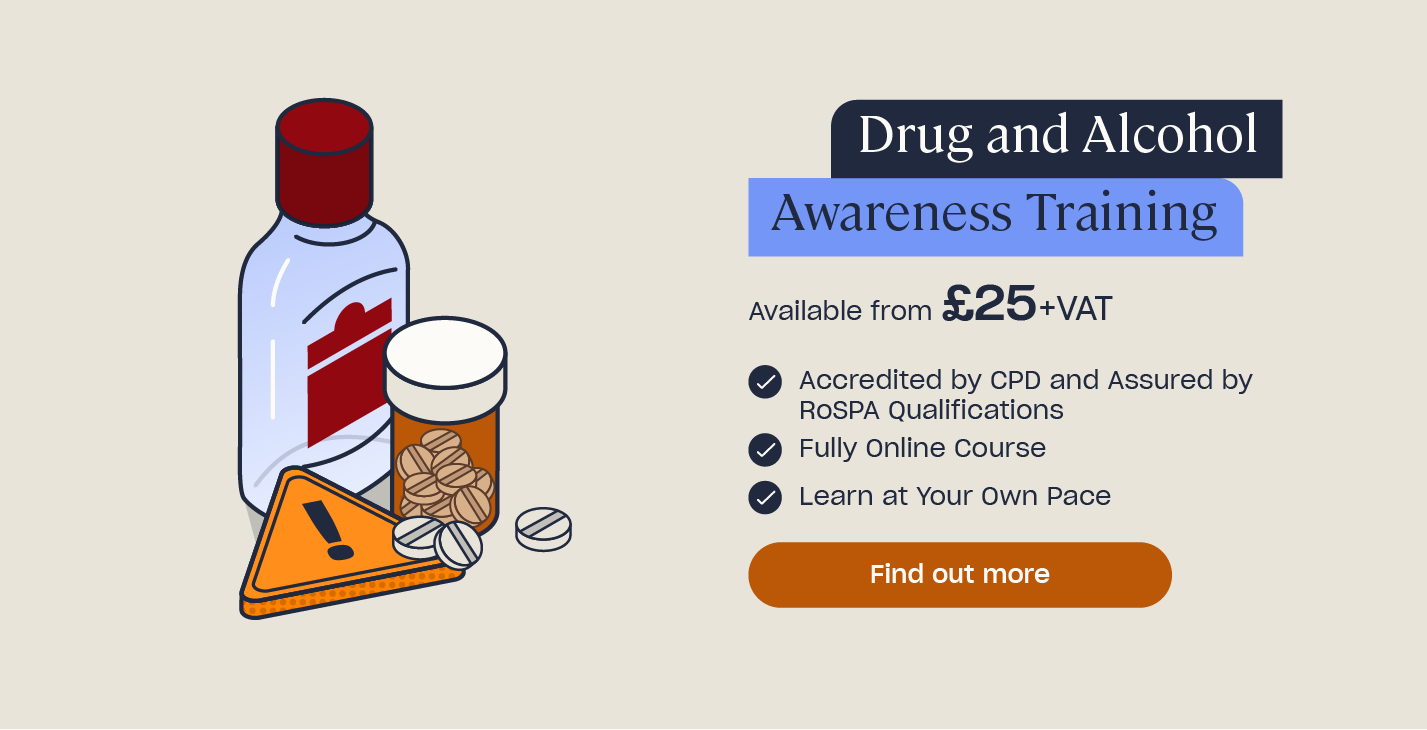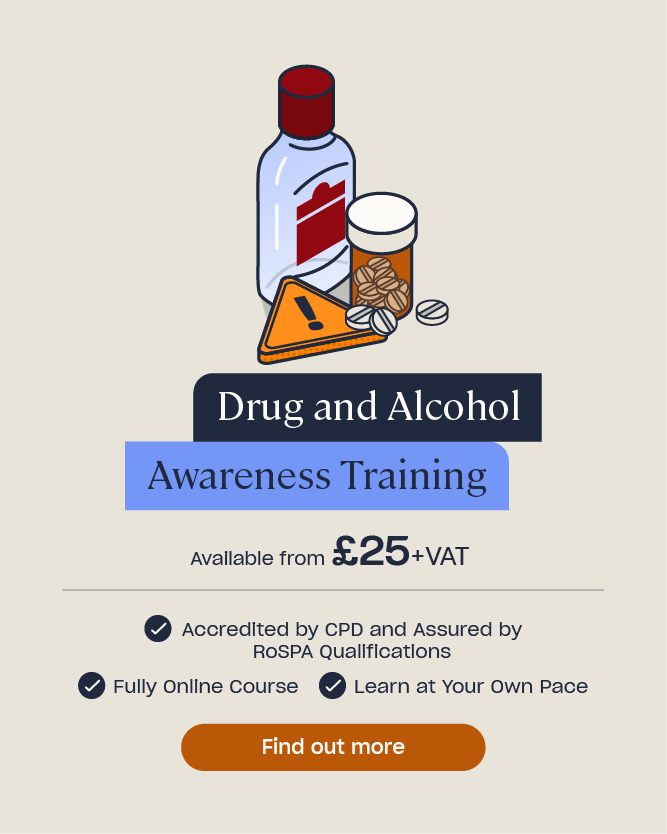Drug and Alcohol Policy Template
Every organisation should consider the potential impacts of drug and alcohol misuse at work and have in place processes to prevent accidents or incidents from occurring and to support employees. A drug and alcohol policy ensures that everyone understands the expectations regarding drugs and alcohol at work and complies with the relevant legislation.
This article will explain why a workplace drug and alcohol policy is essential and what you need to include in your policy. We have also created a drug and alcohol policy template which you can download and tailor to your workplace.

What is a Drug and Alcohol Policy?
The use of drugs or alcohol can seriously impact someone’s behaviour at work, putting themselves and others at risk of harm. In particular, there is a significant risk if safety-critical work is carried out, such as the use of machinery. Drugs and alcohol can have a strong effect on the brain and body, impairing concentration and judgement. If an individual is under the influence of drugs while at work, they may struggle to function normally which could cause them to make mistakes. An employee who misuses drugs or alcohol can also have a negative effect on other employees and damage the organisation’s reputation.
Every organisation will benefit from a drug and alcohol misuse policy. This may form a separate policy, or you may choose to include it within your organisation’s overall health and safety policy. An effective policy must be clear and explain what action will be taken if someone is misusing drugs or alcohol. You should aim to help an employee who is misusing substances by offering them support in the first instance, rather than immediate dismissal. However, your policy must clearly outline when disciplinary action or other steps will be taken. For example, you must immediately report any instance of drug dealing at work to the police.
You should explain the policy to employees as part of their onboarding process and ensure that everyone is able to access a copy of it at any time. You may house the policy on the intranet and communicate this location company-wide. This will ensure that all employees understand the organisation’s position on drug and alcohol misuse and know what action will be taken. It will also outline what an employee should do if they are misusing drugs or alcohol or suspect a colleague of doing so and have concerns.
How to Write a Drug and Alcohol Policy
Every employer has a legal duty to protect the health, safety and wellbeing of their employees and others who work for them. Having an effective drug and alcohol policy forms one part of this duty. It is likely that your employer will delegate the task of producing a drug and alcohol policy to the HR department. They will be made responsible for ensuring all employees understand the policy and know who to go to with any concerns.
To be effective, your drug and alcohol policy must take into consideration your specific work environment and circumstances and be tailored accordingly. For most workplaces, there are some essential aspects that must be covered in all drug and alcohol policies, as explained below.
- Introduction. The policy should be introduced with information on who has responsibility for creating the policy and when it is due to be reviewed. You must clearly and concisely explain the organisation’s position on drug and alcohol use at work.
- Policy objectives. Here, you must set out what the policy aims to achieve. For example, to support early identification of substance misuse at work.
- Scope. You should briefly state who the policy applies to.
- Key definitions. You must explain what is meant by terminology used in the policy, such as what is included by the word ‘substances’.
- The law. This section should outline which laws and legislation relating to drug and alcohol misuse at work must be adhered to. You should also summarise these and make it clear how they relate to substance misuse.
- Drug and alcohol training. As part of the wider drug and alcohol policy, all employees may be required to undergo drug and alcohol awareness training. This can help employees to recognise potential signs of drug or alcohol misuse in themselves or their colleagues. Alongside this, this section of the policy should explain how information on substance misuse will be distributed by the organisation.
- Identifying drug and alcohol misuse. You should summarise the main signs and symptoms that someone may be misusing drugs or alcohol here, while making it clear that these could also be signs of something else. This section should be expanded on during drug and alcohol training.
- Reporting. This section must explain the process for reporting concerns or evidence that an employee is misusing drugs or alcohol at work. Employees must know who to speak to if a colleague confides in them about drug or alcohol misuse and understand that they must keep this information confidential beyond their manager and/or the HR department.
- Prohibited behaviour. You must make it clear what behaviours are prohibited while working for or representing the organisation. The rules concerning the use of legal drugs and the responsibilities employees have regarding this should also be explained.
- Special considerations. There may be some situations where the rules of the policy are amended. This will depend on what the organisation decides on but may include an acceptance of alcohol consumption at work-organised social events outside of work hours, such as at Christmas parties. You must ensure that any amendments are clearly explained and can’t be misinterpreted.
- Manager and supervisor responsibilities. Managers and supervisors have additional responsibilities concerning the misuse of drugs or alcohol at work. They must understand what is expected of them and what they must do if an employee tells them that they have a substance misuse problem. The HR department should support managerial employees to follow the organisation’s policy in these circumstances.
- Support and rehabilitation assistance. Organisations should try to support an employee who is misusing substances. The individual must also be willing to engage with support and work with their employer and others to get better. You should outline what position the organisation takes to drug or alcohol misuse in terms of supporting and rehabilitating the individual. You may help the employee to gain external support from their GP or other services. This section must explain what the absence policy is for employees receiving help for substance misuse and what arrangements could be put in place to support the employee at work.
- Relapse. The procedure for employees who experience a relapse must be explained. For example, is there a limit to how many instances of relapse the organisation will support an employee through?
- Disciplinary action. You must make it clear when disciplinary action could be taken and what form this will take, depending on the circumstances. For example, the steps that will be taken if someone knowingly uses machinery while under the influence of drugs, as this will put them and their colleagues at serious risk of harm.
- Return to work. This section must explain how a return to work following treatment and support for drug or alcohol misuse will be managed by the organisation.
- Drug and alcohol testing. If your organisation chooses to screen and test employees for drug and alcohol use,you must clearly outline the process. Will you conduct random testing or have a policy whereby you can ask an employee to be tested if they are suspected to be under the influence at work? Drug and alcohol testing must be carried out lawfully and fairly. Note that testing for drugs can be more complex than for alcohol consumption. Drug and alcohol screening and testing is most commonly enforced if employees are carrying out safety-critical work. This is because if someone makes a mistake due to their substance use impacting their capabilities, this could result in a serious accident or incident. You must make it clear when and how testing will be conducted, and what will happen if someone refuses to undergo testing.
- Searches and confiscation. Part of your drug and alcohol policy must include details on searches and confiscation of substances. This should outline the rights of the business regarding their premises and the policy on searches of belongings.
- Review. You must review the drug and alcohol policy on a regular basis to ensure that it remains accurate and is amended when necessary. The frequency of review should be stated.
- Drug and alcohol policy certificate of receipt. The drug and alcohol policy should conclude with a signed certificate of receipt to demonstrate that the employee has read and understood the policy, and agreed to follow it.
Workplace Drug and Alcohol Policy Template
We have created a drug and alcohol policy template which you can use as an example when writing the policy for your business. Remember that this template is a guide and you will need to ensure that your policy considers the work activities and other circumstances specific to your organisation. You can download our drug and alcohol policy template below:
An effective drug and alcohol policy is an important part of an organisation’s wider health and safety policy. You should approach the issue of substance misuse at work with the aim of supporting and helping any employee who is misusing substances, provided they are willing to help themselves. Every employee must understand the organisation’s position on drug and alcohol misuse at work and know what to do if they, or a colleague, develop a problem.
Further Resources:
- Disciplinary Procedures in the Workplace: Guide for Employers
- Drug and Alcohol Awareness Quiz
- A Guide on Recognising the Signs of Drug and Alcohol Abuse







